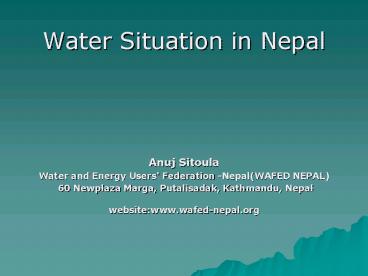Water Situation in Nepal - PowerPoint PPT Presentation
1 / 16
Title:
Water Situation in Nepal
Description:
The population in Nepal is estimated as 26 million. 83% rural and 17% urban ... Employee started protesting as their demand while forming KUKL are not fulfilled. ... – PowerPoint PPT presentation
Number of Views:896
Avg rating:3.0/5.0
Title: Water Situation in Nepal
1
- Water Situation in Nepal
- Anuj Sitoula
- Water and Energy Users' Federation -Nepal(WAFED
NEPAL) - 60 Newplaza Marga, Putalisadak, Kathmandu, Nepal
- websitewww.wafed-nepal.org
2
Economy
- The population in Nepal is estimated as 26
million. 83 rural and 17 urban - The total area of the country is 147,181 km2.
- Nepals overall poverty rate is estimated at 29
- GDP composition is 40 from agriculture, 20 from
industry and 40 from services,
3
Nepal Water Resources
- Annual rainfall varies from 500 mm/yr in western
areas to more than 4,000 mm/yr on the southern
slopes of the Himalayan range, with 70-80
occurring in summer (monsoon) - Nepal has more than 6,000 rivers
- All the river systems drains from North to South
towards the Ganges. - The total average annual run-off from all these
river systems is estimated at about 230 billion
cubic meters (BCM).
4
Estimates of Nepals potential water use in 2027
Surface and Groundwater, Source GON 2002,
Table 3.129
5
Groundwater Resources
- It is estimated that rechargeable groundwater in
the Terai is between 5.8 BCM and to 11.5 BCM. - About 756 MCM of groundwater resources are being
used for irrigation purposes and 297 MCM for
domestic uses.
6
Existing Water Use
- Out of 230 BCM of water available annually, only
a small part of it (about 15 BCM) has so far been
utilized for economic and social purposes. - Medium and small rivers are used for different
uses such as drinking water, irrigation and
hydropower. - Few run-of-the river schemes on the tributaries
of Himalayan rivers, are also developed for
hydropower generation.
7
Contd..
- 77 of the countrys population has access to
basic water supply. - Most of the completed urban water supply
systems are not delivering water satisfactorily. - In the rural areas, the government has been
handing over management of the systems to the
communities concerned.
8
Contd..
- Nepal has 2.64 million hectares of cultivable
land, of this land only 66 i.e. 1.76 million
hectares, is irrigable. - Around 60 of the irrigable land has some kind
of irrigation facility, and less than one-third
has round-the-year-irrigation. - Total installed electricity generation capacity
of about 619, MW, of which the hydropower
capacity is 562MW. - Water quality issues have not received
sufficient attention, as the focus so far has
been in water development and supply.
9
Management of Water Supply
- Department of Water Supply and Sewerage (DWSS).
- Nepal Water Supply Corporation (NWSC).
- Users Committee.
- Kathmandu Valley Drinking Water Ltd (KUKL).
10
Cost of Drinking Water
- Minimum Rs 50 for first 10,000 ltr.
- Beyond this Rs 15 for every 1,000 ltr.
- Yearly increment of water tariff by 15 percent.
- Price remains steady for last three years.
11
Water demand in Kathmandu
- Demand of 270 million Liters per day.
- Output of 180 million Liters per day.
- During dry season output of 95 million liters per
day. - Leakage of 40-70 percent.
12
Melamchi Water Supply Project
- Inter basin water transfer project.
- Aims to divert 170 million ltrs per day from
Melamchi river to Kathmandu valley, through 26.5
km tunnel. - Time period of the project is 5 years.
- Cost of the project- 317.3 million US, which is
32 less from original cost of 464 million US . - Financer of the projects are ADB-137 million,
JBIC-47.5, JICA-18, OFID 13.7, NDF -10.5, Nepal
Government -90.6 million.
13
Pre-Condition
- Privatisation of Nepal Water Supply Corporation
(NWSC). - Management of public water system should be
replaced by a private operator. - Full cost recovery principle.
- Rising of water tariff by at least three fold.
14
Privatisation of drinking water
- Formation of Kathmandu Valley Water Management
Board (KVMMB), Kathmandu Valley drinking water
Ltd (KUKL), Water Tariff Fixation commission. - KUKL, had taken charge of managing the supply of
drinking water for the valley since 3 February
2008. - The transfer of responsibility from Nepal Water
Supply Corporation to the company as
pre-condition set by Asian Development Bank for
grant and loan.
15
Progress of KUKL
- Water supply system have not improved since last
six month. - Employee started protesting as their demand while
forming KUKL are not fulfilled. - Kathmandu Metropolis which hold 30 share claims
that KUKL is unsuccessful and if this trend
continues it will withdraw its share from the
company.
16
- Thank You































